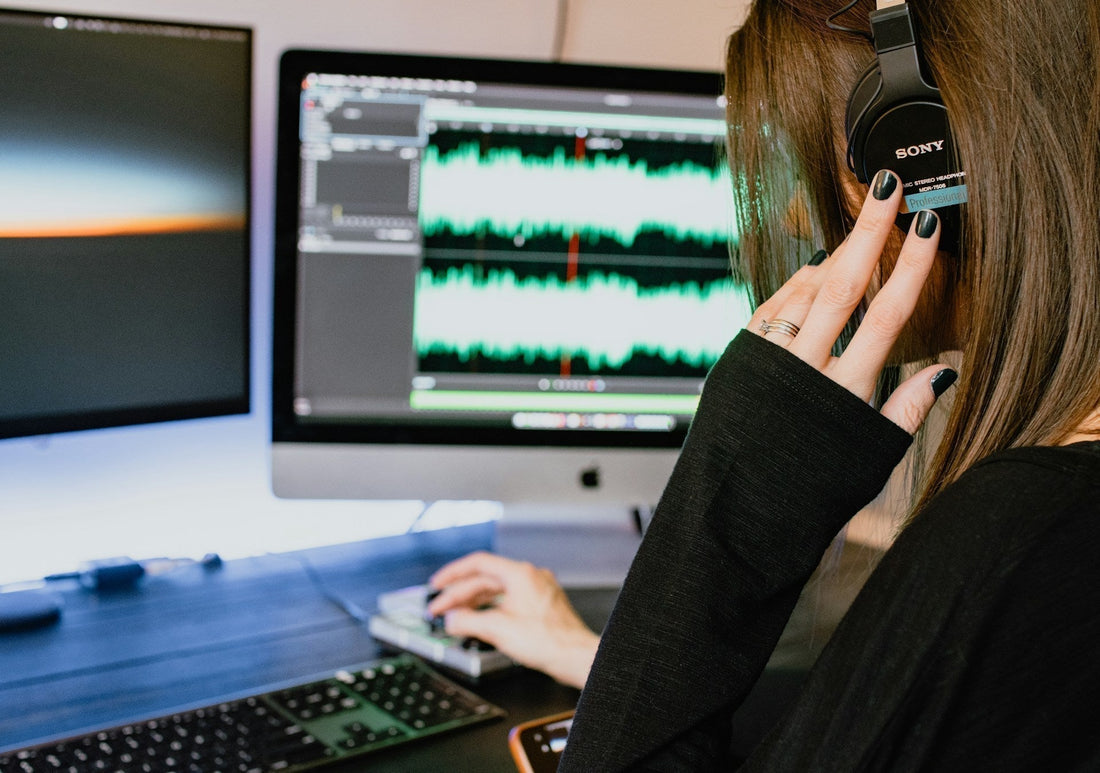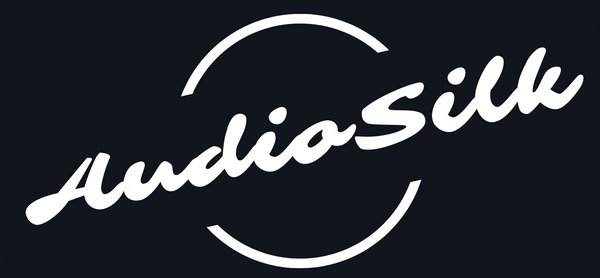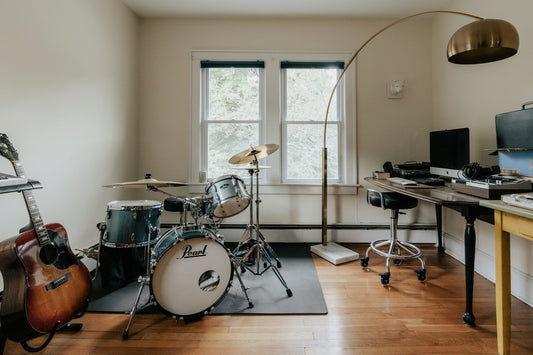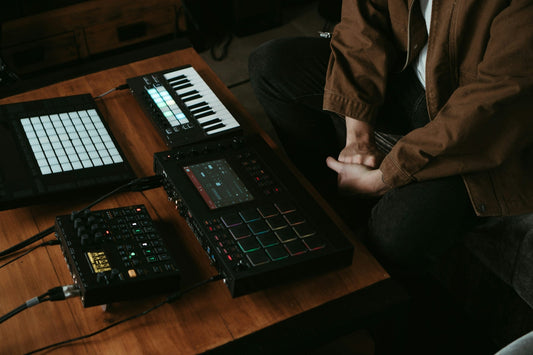
How to Become a Musician: Your Complete Step-by-Step Guide for 2025
Share
You've got that melody stuck in your head from this morning. The beat you programmed last night won't stop looping in your brain. That guitar riff you stumbled onto gives you chills every time you play it.
But here's the problem: turning those lightning-in-a-bottle moments into an actual music career feels impossible.
There’s the technical side of things. The competition. The vast number of people also trying to make a career out of music. Even if you’ve got the skills and determination to do it, over 61% of all music uploads now come from independent artists.
Plus, with global streaming revenues hitting $29.6 billion, the opportunities are real, but so is the competition.
That said, with hard work, determination, a plan, and a sprinkle of luck, you can absolutely build a career.
We’ll say right off the bat, don’t expect this to happen overnight.
However, starting off small with streaming services, local gigs, album releases, you can earn up to $15,000 a year and a sustainable career, and then grow from there year on year as your skill and popularity grow.
Even if you’re working now from a home studio.
This isn't another "follow your dreams" pep talk. This is the real roadmap—no sugarcoating, no get-rich-quick schemes. Just the step-by-step process that successful musicians use to transform passion into profession.
Let's start with the foundation every musician needs.
Step 1: Master the fundamentals (first 6-12 months)

The path from musical curiosity to competent creator depends largely on where you're starting.
Complete beginners typically need 6-12 months to reach basic competency, while those with some musical background can achieve intermediate skills in 3-6 months.
But here's what most people get wrong: they think talent matters more than structure. It doesn't.
Choose your learning path wisely
You've got more learning options than any generation of musicians before you, but that can actually make things harder. Here's how to cut through the noise:
App-based platforms like Yousician and Fender Play cost $10-20 monthly and offer gamified learning experiences. They're convenient and budget-friendly, but lack personalised feedback when you're developing bad habits.
Private lessons run $50-90 per session and provide crucial technique correction, but they're expensive and require scheduling coordination.
The most effective approach?
Use apps for daily practice and schedule monthly lessons for technique correction. This hybrid method gives you consistent progress tracking while ensuring you don't cement mistakes into muscle memory.
Essential skills every modern musician needs
Forget the romantic notion of the "natural-born musician." Every successful artist masters these three foundational skills that separate professionals from hobbyists:
Ear Training (3-6 months for proficiency)
- Your secret weapon for musical communication
- Use apps like EarMaster and ToneGym for 10-20 minutes daily
- Progress: interval recognition → chord identification → transcription abilities
- Result: Learn songs by ear and communicate ideas effortlessly
Rhythm and Timing
- Start with a metronome at 60-80 BPM, gradually increase
- Essential for ALL musicians, not just drummers
- Solid timing = the difference between amateur and professional recordings
- Even electronic producers need rhythm fundamentals for groove and feel
Music Theory Basics (don't panic—no degree required)
- Weeks 1-4: Scales and basic chord construction
- Weeks 5-12: Chord progressions and song analysis
- Result: Communicate with other musicians and understand your own creations
- Bottom line: Theory explains what sounds good—it doesn't limit creativity
These three skills form the foundation that everything else builds on. Master them, and watch your musical capabilities explode across every genre and context.
Practice structure that actually works
Here's where most people fail: they practice without structure, then wonder why they plateau.
Use this daily template: 5 minutes of warm-up, 15 minutes of technical work, 20 minutes on repertoire, and 5 minutes of creative exploration. The key insight: 15 minutes daily beats sporadic 2-hour sessions every time.
Create practice triggers by linking to existing habits—after morning coffee, before dinner, during lunch breaks. Keep instruments visible and accessible. Track progress through practice logs and monthly recordings to push through inevitable plateaus.
Step 2: Build your home studio (budget-conscious approach)

Professional-quality recordings are now possible on modest budgets. The democratisation of music production means your bedroom can compete with major studios—if you know what you're doing.
The $500 starter studio
You can create a usable music with this setup:
- Audio interface: Behringer UMC22 ($40)
- Microphone: Audio-Technica AT2020 ($99)
- Headphones: Sennheiser HD 280 Pro ($90)
- MIDI controller: Akai MPK Mini ($120)
That's under $400, leaving room for cables and accessories. Combined with free software like GarageBand or Cakewalk, this setup can produce music that gets radio play.
The $1,000 sweet spot
When you're ready to level up, strategic upgrades make dramatic differences:
- Upgrade to Focusrite Scarlett 2i2 interface ($200)
- Invest in basic acoustic treatment, like AudioSilk acoustic wall panels ($200)
Here's the critical insight most people miss: a treated $500 studio outperforms an untreated $5,000 studio every time. Room acoustics matter more than expensive gear.
Software selection strategy
Your DAW choice shapes your creative workflow, so choose wisely:
- Mac users: Logic Pro ($200) offers incredible value with its massive sound library and intuitive interface. You get everything needed for professional production.
- Windows users: Cakewalk (free) provides full professional features, while Reaper ($60) offers unmatched customisation options.
- Electronic music producers: Ableton Live ($450) revolutionises workflow with its unique session view and performance capabilities.
Golden rule: Master your DAW's stock plugins before buying third-party options. Modern DAWs include everything needed for professional production—additional plugins should solve specific problems, not compensate for skill gaps.
Room acoustics: Your secret weapon
As above, this is where AudioSilk acoustic panels can turn your studio from amateur to professional.
Even basic room treatment at first reflection points dramatically improves your ability to make accurate mixing decisions. For serious home studio creators, professional acoustic panels provide superior results and aesthetic appeal that match your artistic vision.
Immediate improvements you can make today:
- Hang thick curtains over windows
- Add rugs to hard floors
- Position bookshelves for natural sound diffusion
Remember: every dollar spent on acoustic treatment saves hours of problematic mixing decisions later.
Step 3: Develop professional skills and mindset

Technical skills are just the beginning. Professional musicians think differently about their craft, their business, and their long-term development.
The production learning curve
If you're creating music in a home studio, production skills are as important as instrumental ability. Here are realistic timelines:
- MIDI programming basics: 1-2 months
- Sound design and synthesis: 3-4 months
- Professional mixing skills: 6-12 months
Be patient with this process. Shortcuts don't exist—every professional producer went through this learning curve.
Follow this skill progression: Start with basic signal flow understanding, then master EQ and compression techniques.
Next comes spatial processing (reverb and delay), followed by advanced concepts and mastering basics. Each stage builds on the previous, creating comprehensive expertise.
Building your musical identity
Finding your unique sound happens gradually over months 6-18. Study your influences obsessively—not just their final products, but their creative processes. Experiment with genre fusion and document everything. Failed experiments teach as much as successes.
Critical insight: Authenticity trumps technical perfection. Listeners connect with genuine emotion and a unique perspective more than flawless production.
Creative workflow development
Every musician faces creative blocks. Here's how professionals push through:
The "10-minute rule": Commit to just 10 minutes of daily creative work. This minimal commitment often leads to longer sessions while eliminating the pressure of marathon productivity sessions.
When blocks persist, change your environment—even moving to a different room can trigger fresh perspectives. Collaboration sparks creativity, so find online communities like r/WeAreTheMusicMakers or genre-specific Discord servers.
Professional secret: 100 finished songs rated 7/10, beat 10 unfinished songs that could be 10/10. Set artificial deadlines and embrace "good enough" over perfect.
Mental health and sustainability
73% of independent musicians experience mental health challenges. The combination of irregular income, constant rejection, and creative pressure creates unique stresses.
Build resilience by distinguishing constructive feedback from destructive criticism. Constructive feedback offers specific improvements; destructive criticism entertains or hurts without helping.
Resources that understand musicians: Help Musicians (UK) offers 24/7 support at 0808 802 8008. MusiCares (US) provides financial assistance and runs weekly online support groups.
Remember: seeking help demonstrates strength, not weakness. Mental health directly impacts creative output and professional success.
Step 4: Navigate the modern music business

The traditional record deal no longer represents the only path to success. Independent artists now keep 100% of their streaming royalties (minus distributor fees) and maintain complete creative control.
But this freedom comes with responsibility for every aspect of your career.
Understanding today's music economy
Let's address the streaming elephant in the room. Spotify pays approximately $0.003 per stream, meaning one million streams generate around $3,000. However, streaming serves primarily as a discovery tool rather than a primary income source.
Here's the reality: Only 5% of full-time musicians cite streaming as their main income source. Successful musicians diversify across multiple revenue streams:
- Live performance: 28%
- Teaching: 22%
- Recording services: 15%
- Merchandise: 12%
- Licensing/sync: 10%
- Other music-related work: 13%
Building your fanbase strategically
Modern fan relationships transcend traditional artist-audience dynamics. Focus on building genuine connections rather than chasing vanity metrics.
Platform-specific strategies:
- TikTok: Great for discovery and viral potential, but poor conversion to sales
- Instagram: Perfect for visual storytelling and behind-the-scenes content
- YouTube: Ideal for long-form content, tutorials, and deeper connection
- Email lists: Your most valuable asset—direct access to the most engaged fans
The superfan strategy works: a small percentage of your audience often generates the majority of revenue through merchandise, concert tickets, and direct support. Platforms like Patreon enable monthly subscriptions, though realistic expectations suggest $450-500 monthly income with dedicated effort.
Content that actually converts:
- Behind-the-scenes studio footage
- Song breakdown explanations
- Live acoustic versions
- Personal stories behind songs
Legal and business essentials
Protect your work from day one. Copyright registration costs $35-85 but provides crucial legal protection and eligibility for statutory damages. Register with a Performing Rights
Organisations like ASCAP ($50 one-time fee) or BMI (free) collect performance royalties.
Business structure decisions:
- Start as a sole proprietor (simplest option)
- Consider an LLC with around $30,000 annual income
- S-Corporation election becomes advantageous at around $60,000 annually
Use accounting software like QuickBooks Self-Employed ($15/month) to track expenses. When income exceeds $50,000, invest in a music industry accountant—professional financial management often pays for itself through identified deductions.
Marketing without breaking the bank
Content planning prevents creative burnout. Batch-create content during productive periods, maintaining a 4-6 week buffer. Use scheduling tools like Buffer ($6/month) to maintain consistency without constant attention.
Email list building strategy: Offer exclusive content for signup—demos, acoustic versions, behind-the-scenes footage. Target 20-25% open rates to indicate healthy engagement. Monthly newsletters maintain a connection without overwhelming subscribers.
Step 5: Make the professional transition

The leap from hobbyist to professional requires more than musical skill. Here are the financial and strategic benchmarks that indicate readiness.
When to go full-time
Financial benchmarks for the professional transition:
- $30,000+ annual music income
- 6-12 months of expenses saved
- 3-4 reliable revenue streams established
- Consistent growth trajectory over 12+ months
The average timeline for this transition is 3-5 years of consistent effort. Those who succeed combine strategic planning with relentless skill development.
Building your team: Managers typically earn around $50,000 annual income (they take 15-20% commission). Booking agents become valuable when you're consistently selling 100+ tickets per show (10-15% commission). Choose team members based on passion for your music, not just their roster or promises.
Income progression reality
Set realistic expectations based on career stage:
- Beginners (0-2 years): $1,450-$13,327 annually
- Intermediate (2-5 years): ~$11,523 average
- Professionals (5+ years): $49,437-$71,167
Location significantly impacts earnings: New York musicians average $87,177 while smaller markets hover around $35,000-$45,000.
Success metrics that matter
You will at least a bit, but try to avoid falling into the trap of vanity metrics.
Follower accounts can feel like a good metric, but a lot of people following will be other artists looking for follows back, spam and bot accounts, and the odd fan here and there. It’s not a real sign of growth.
Instead, beyond money, track engagement metrics that reveal true fan connection:
- Monthly listener growth rate
- Email list engagement (20-25% open rate indicates health)
- Revenue per fan calculations
- Fan lifetime value
Realistic goal progression:
- Year 1: 1,000 monthly listeners, $2,000-$5,000 income
- Years 2-3: 5,000 monthly listeners, $10,000-$15,000 income
- Years 4-5: 20,000+ monthly listeners, $25,000-$40,000 income
Remember: 1,000 true fans can support a full-time music career.
Your action plan starts here
Success as a modern musician requires balancing artistic vision with business acumen. The tools for professional music creation have never been more accessible—but the competition has never been fiercer.
Your immediate action plan:
- This week: Set up your basic home studio and establish daily practice routine
- This month: Choose your learning platform and start systematic skill development
- Month 2: Begin creating and sharing content consistently
- Month 3: Start building your email list and social media presence
Truth is, those thriving in 2025 aren't necessarily the most talented—they're the most persistent, strategic, and adaptable.
But talent without proper tools is just potential.
Your home studio setup determines whether your musical ideas translate into professional-quality recordings that compete in today's market.
AudioSilk acoustic panels ensure your creative space delivers the accurate monitoring you need to make confident mixing decisions.
Why settle for "bedroom producer" sound when you can achieve professional results?
Every successful artist started as a beginner facing the same doubts you have today. The difference between dreaming about a music career and building one lies in taking consistent action with the right foundation.
Ready to stop compromising on your sound quality? Get AudioSilk panels and transform your space into a professional, creative environment.
Use code BLOG10 for 10% off your musical future →
The tools are available, the pathways are proven, and the opportunities are real. Now it's time to sound as professional as your ambition.



